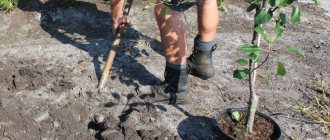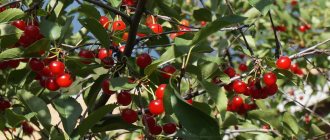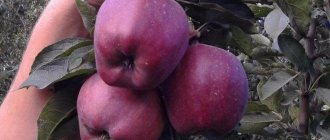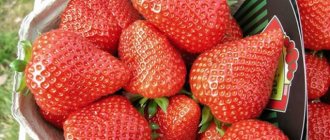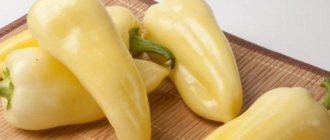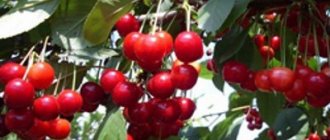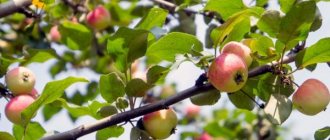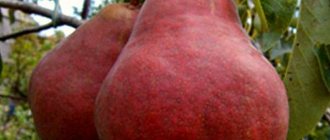Loading…
Loading…
The first cultivated varieties of squash had a white skin color and a regular fruit shape with a slightly wavy edge. Today, gardeners can choose from dozens of varieties of different ripening periods, shapes and colors. Young fruits with thin skin that has not yet hardened are used in cooking and canning, and ripe squash is stored no worse than pumpkins and can be used in winter.
Modern varieties of squash are divided into:
- early, allowing you to get the first harvest 40–50 days from the moment the first shoots appear above the ground;
- mid-ripening, bearing fruit after 50–60 days;
- late, forming an ovary after 60–70 days.
In addition to the fact that squash bushes can produce healthy and tasty pumpkins, certain varieties with an unusual “horned” shape of the fruit and variegated coloring are a wonderful decoration for the site.
And among vegetable varieties there are not only white-fruited varieties of squash. Fruits with yellow, orange and green coloring of the peel and pulp are no longer uncommon. What do different varieties of squash look like and what are the advantages of this or that variety?
Patisson variety White 13
This white-fruited variety with strong branched bushes is considered one of the best for open ground. Disc-shaped fruits with weakly expressed segmentation can be cut after 55–67 days. Pumpkins of this variety of squash, in the photo, have smooth thin skin and dense, unsweetened white pulp, reminiscent of the taste of zucchini. The average weight of squash is from 0.3 to 0.5 kg; up to 3.5 kg of young fruits of universal use are obtained from a bush per season.
Tips for caring for crops
Caring for squash is no more difficult than caring for zucchini. But in addition to watering and fertilizing, they need the “help” of a gardener for pollination. Insects also carry pollen, but you shouldn’t rely too much on them, especially if the weather is cool and damp during flowering. To attract bees and bumblebees to the area, the buds are sprayed with honey or sugar syrup diluted with water (20–30 ml per liter).
Gardeners carry out pollination of squash by hand
Female flowers can be easily distinguished from male flowers by the presence of a fruit ovary at the base of the bud. To pollinate a male flower, you need to tear off the petals and pass the pistil over the stamens several times. Pollen is also transferred using a soft brush or cotton pad. Pollination is carried out exclusively in dry weather.
The female squash flower can be distinguished by the presence of a fruit ovary
The bed needs to be weeded and loosened regularly, but very carefully. The root system of plants is superficial. It is advisable to mulch the soil. This will help retain moisture in the soil, prevent weeds from breaking through and protect the roots from drying out.
If the flowering of squash is delayed, experienced gardeners recommend cutting off 1-2 of the oldest leaves from the bush. After 4-5 days the procedure will need to be repeated. It is carried out early in the morning.
Like all pumpkin plants, squash loves moisture. Before flowering, they are watered with water at room temperature every 5–6 days, spending about 10 liters of water per 1 m². After the ovaries are formed, the interval between waterings is reduced to 3–4 days, and the rate is increased to 10–12 liters. Water is poured under the roots or into the furrows between the bushes. It is undesirable for drops to fall on leaves, flowers and fruits.
Squash, like all pumpkin plants, need frequent and abundant watering
A piece of plywood, glass, roofing felt, etc. must be placed under the formed fruits lying on the ground to protect them from contact with wet soil. Otherwise, the development of rot is almost inevitable. For the same purpose, old withered leaves and remains of flower petals are removed from the fruit ovary.
The vegetative period of squash is quite short, so two feedings are enough for the plant. Before flowering, 40–50 g of potassium and phosphorus fertilizer and half as much nitrogen fertilizer are distributed over the bed in dry form. You can also use complex preparations - Azofoska, Ammofoska and so on.
Ripening fruits need phosphorus and potassium. Nitrogen stimulates the bushes to intensively grow green mass; they have no energy left for the squash themselves. 5–7 days after the formation of fruit ovaries, the squash is watered with an infusion of fresh manure, bird droppings, nettle or dandelion leaves. It is prepared within 3–4 days. Before use, the product is filtered and diluted with water 1:10 or 1:15 if it is litter. Any fertilizer based on vermicompost or an infusion of wood ash will also work. Each plant consumes about 0.5 liters.
Nettle infusion is a natural source of phosphorus and potassium
Video: recommendations for caring for squash
Patisson variety Disc
From germination to harvesting the first delicious fruits of this wounded variety, it takes from 47 to 53 days. Young fruits, set on a powerful bush, first have a greenish tint, then turn white. The shape of squash is close to a bell, the lower part of the fruit is flattened, the upper part is almost spherical. The diameter of a mature fruit with high commercial qualities is 18–22 cm, weight is about 0.35 kg. Ripened squash stores well until mid-winter, and the ovary at the age of 3-5 days is most tasty in canned vegetables and grilled.
Planting a plant with seeds
Planting a crop differs in the methods of growing and caring for seedlings.
Planting squash in open ground using the seedless method involves sowing directly into the beds.
The optimal time for this is the end of May or the beginning of June.
To determine the timing, you need to focus on the condition of the soil.
The earth should warm up to +10°C.
Otherwise, the seeds may simply rot and not germinate, since squash loves heat very much.
When the squash grows, it will look like spreading bushes.
Thus, you need to correctly determine the distance between plants so that in the future they have enough light and space.
Vegetables can be planted using the square-cluster or strip method.
The tape method involves planting crops according to a 50x90x70 cm pattern.
With the square-cluster method, 60-70 cm are removed from each hole.
Having prepared the holes in advance, place the seeds.
Place 2-3 seeds in each hole.
The depth of planting squash seeds depends on the type of soil.
For example, if the soil is heavy, you need to plant the seeds to a depth of 3-4 cm.
With light soil, it is enough to deepen it to 5-7 cm. Sprinkle everything on top with earth and water it.
It is preferable to use drip irrigation so as not to wash out the seeds of their holes. To speed up seed germination, the beds are covered with film.
After emergence of shoots, the film is removed. When the sprouts get a little stronger, you need to thin them out.
In this case, the strongest and healthiest plants are selected, the rest are removed. You can also plant seedlings in neighboring beds.
Patisson Sunny Bunny F1
You can collect fruits from the powerful bushes of this hybrid within 42–45 days after seed germination. Plants are distinguished by massive and very massive fruiting. At the same time, there can be up to 20 young squash of this variety on the bush, as in the photo they have a beautiful disc-shaped shape, ribbed edges and a bright, rich yellow color. The average weight of squash ready for harvest is 150–250 grams. The pulp is cream or light orange, excellent taste and dense consistency. The bushes are resistant to powdery mildew infection. Purpose – culinary and for home preservation.
Harvesting
Patisson is a plant of continuous fruiting. As soon as one fruit is cut, the next one will immediately begin to grow on the bush. While the fruit is growing, it delays the formation of new ovaries and their growth, so there is no need to grow the fruit to a very large size. In addition, large fruits have a rough peel. They are grown only for exhibitions and for winter storage.
Ripe fruits can be stored indoors for several months. For eating, you need to remove young ovaries with a diameter of no more than 10-12 cm. At this time, they are tender and good for any dishes. For canning, you need to collect fruits with a diameter of 4-5 cm. Fruits with a larger diameter will have to be cut into slices.
Patisson variety Gosha
The disc-shaped fruits of the early variety are ready for harvesting 46–52 days after the start of plant development. The bushes are large and tall. In the photo, the squash variety, at the stage of technical ripeness, is painted in a dark green color, becoming more saturated, almost black by the time the fruits are biologically ripe. Average weight is about 300 grams. The fruits of the Gosha variety have a dense, crunchy texture that is preserved during canning.
The plants bear fruit for a long time and uninterruptedly, are resistant to diseases and rot, the fruits are decorative and tasty.
How to prepare for landing
The first step is to choose a suitable location on the site. Culture loves light and warmth. A shaded place has a bad effect on the development of the plant, so it is better to plant the vegetable in a sunny place.
It is good if the site is protected from strong gusts of wind and the sun's rays are diffused.
Such a place will be the best for growing squash in open ground.
Sowing time
To get a high-quality, tasty harvest, you need to take the issue of planting vegetables seriously.
Incorrect sowing time may result in the vegetable not having time to ripen before the onset of cold weather.
The climatic conditions of the country vary greatly in different regions, so sowing dates differ.
The table shows the approximate time that is suitable for a particular region of the country.
Table 1. Dates for sowing squash in open ground by region of Russia:
| Sowing time | Country region |
| May 15-20 (with shelter), May 20-30, June 5-10 | Moscow region and middle zone |
| May 10 -June 15 | Central |
| April 20 – May 10 | Southern |
| From June 15 | Far East |
| Greenhouse | Northwestern |
| Greenhouse | Siberia and the Urals |
Features of soil preparation
The recommended soil for vegetables is chernozem, light loam. The optimal choice is neutral soil, this way you can avoid mistakes.
If the soil is acidic, wood ash is added to it.
Soil preparation for squash is carried out in autumn or spring. In this case, an important issue is the application of fertilizers, which affect the quality and quantity of the crop.
Autumn preparation
To properly prepare a bed for a crop, you need to follow the instructions:
- First, the previous culture is removed.
- They dig up the soil with a rake, remove the rhizomes of plants and weeds.
- Fertilizers are also applied in the fall. Humus or compost is used for digging. At the same time, light soils need less organic fertilizers, heavy soils need more.
Spring training
In early spring, after the snow has melted, when the soil has warmed up, they begin to prepare it.
To do this, loosen it 2 times and harrow it. The first time loosening is carried out to a depth of 5 cm.
Right before sowing, you need to loosen the soil again. Here the depth is already smaller - 10 cm. At this stage, all weeds are also removed.
Fertilizing the soil and preparing seeds before planting
Before planting squash, add 5 kg of humus, 40 g of superphosphate, 25 g of potassium salt per 1 square meter.
All fertilizers are distributed in such a way that they are distributed evenly throughout the entire area.
Regardless of the method of growing vegetables, planting material must be prepared for sowing:
disinfect, warm, harden, treat with growth stimulants.
The first stage is warming up. To do this, you need to place the planting material in an oven heated to 50°C.
Heat the seeds for 5 hours. You can also warm them up on a battery for 7 days. Warmed seeds need to be cooled.
Next, they begin etching. Planting material can be disinfected in a 1% solution of potassium permanganate.
To treat, simply dip the seeds in the bright pink solution and soak for 20-30 minutes. Then rinse with clean water and dry.
You can harden the planting material in the refrigerator. It is enough to put it on the bottom shelf for 6 hours.
The last stage will be treatment with growth stimulants. They are purchased in the store, these are the drugs Epin, Buton, Energen.
You can also use folk remedies. Experienced gardeners use aloe juice diluted with water to accelerate seed germination.
After all the procedures performed, the seeds are washed with clean water and placed on damp gauze for 2 days.
During this time, you need to ensure that they are constantly wet.
The air temperature in the room at this stage should be +23°C.
Patisson in the garden: combination with other plants
To increase the yield and prevent the occurrence of many diseases, it is important to choose the right environment for the crop.
It is best if they grow together with radishes, onions, garlic, and corn.
It is also good to grow squash together with borage, thyme or nasturtium. Marigolds planted next to the vegetable will help repel aphids.
The combination of squash with pumpkin, beans or cabbage makes caring and planting easier. In this case, you can harvest one crop and plant another.
The planting of greenery is also successful. For example, dill or lettuce.
Potatoes will be a bad neighbor for squash. However, if you plant a vegetable in the place where there used to be potato tubers, it will please the gardener with a good harvest.
It is also not recommended to grow squash and zucchini next to each other. They are related plants.
To prevent cross-pollination, the vegetable should not be planted next to cucumbers. Beets are unfavorable neighbors for squash.
Harm of pumpkin
Despite the positive qualities of this wonderful vegetable, it also has negative properties. Consumption of squash by certain groups of people can have a detrimental effect on their health.
Let's look in detail at what ailments it is not recommended to consume them.
We recommend reading:
- The benefits and harms of leeks - their effect on the human body. Review of the composition and rules for using leeks (110 photos and videos)
The benefits of tomatoes and harm to the body: indications and contraindications for the use of tomatoes (110 photos and videos)
The benefits and harms of arugula: beneficial properties for the body and contraindications for use (95 photos and videos)
- “Sunny” zucchini should not be consumed by people suffering from acute disorders of the digestive system.
- It is not recommended to eat squash for people suffering from hypertension.
- Consumption of butternut squash may increase the risk of gallstones and kidney stones.
- These vegetables are contraindicated for diabetics and children under 10 years of age.
Squash have a huge number of positive properties. They help the body get rid of unnecessary substances, contain many vitamins, and are used in medicine.
Plate pumpkins are delicious and have virtually no contraindications.
